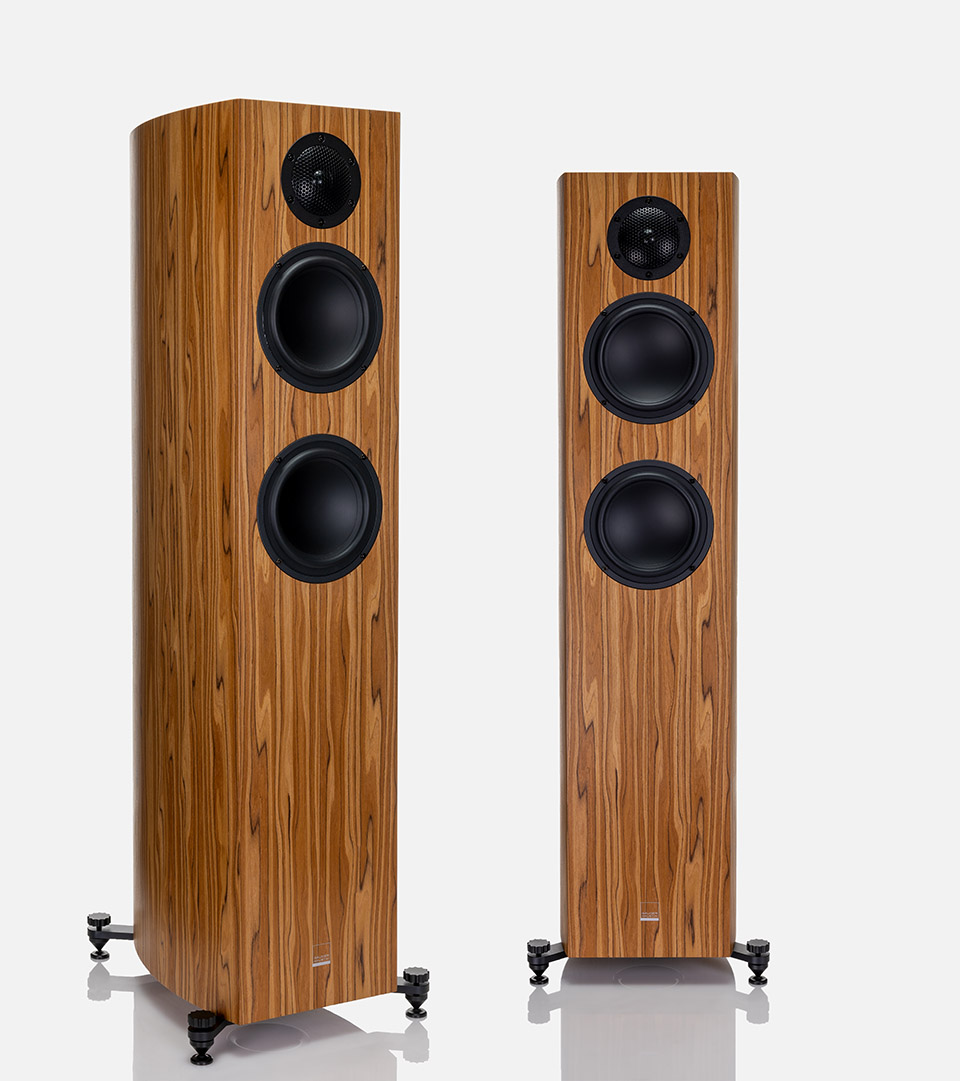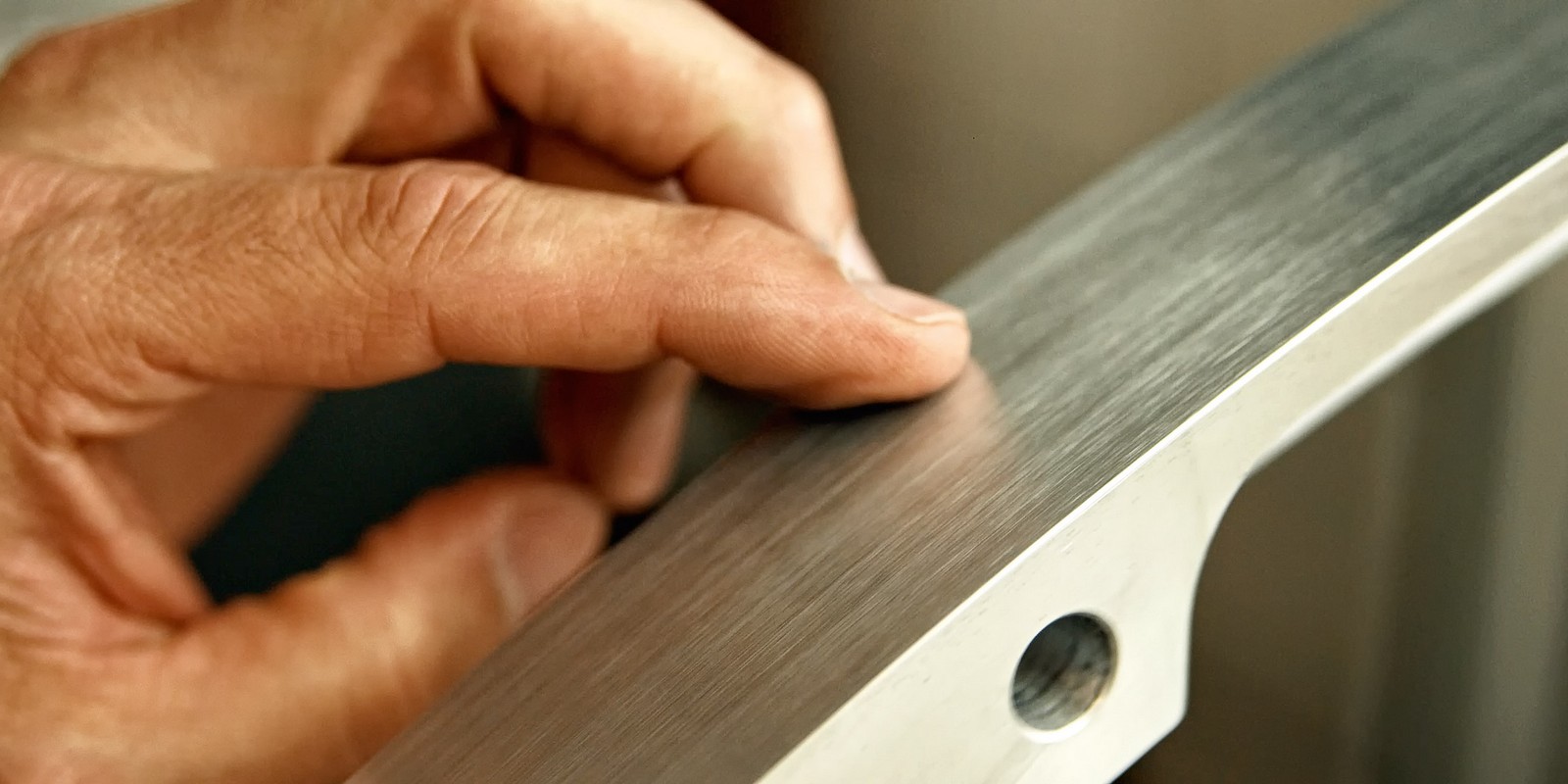
The new Capello series combines everything that is innovative and progressive in loudspeaker construction and brings a fullness of sound and dynamics that was previously unheard of. Whether it's improvements in cabinets, speaker drivers or crossovers, the heart of a speaker, or whether it's the ingenious combination of all the details, listen to these speakers at your leisure and see why we are so proud of them!
The Capello series contains the essence of all the predecessor series that have been so successful worldwide. Technical developments are rarely so obvious from the outside, but you'll know what we're talking about as soon as you hear the first notes.
You can find an overview of all models here
The aluminum tweeter in our Capello series impresses with its soft timbre and hard attacks. You are welcome to experience its outstanding sound at your specialist dealer. Stunningly good!
The quality of the tweeter determines the resolution and impulse-faithful detail reproduction of a loudspeaker. In accordance with Newton's law, a low moving mass and a strong magnetic drive are particularly important here, whereby the membrane must of course be able to follow all these deflections. In collaboration with a German tweeter specialist, we developed a beryllium dome tweeter whose moving mass is just half the size of all previously used tweeters. In combination with the ultra-strong iron-neodymium magnet, this results in an impulse fidelity that previously seemed impossible.
Of course, midrange cones do not have to be able to follow such high accelerations, but they must be much larger than tweeter domes in order to emit the same sound pressure. Large diaphragms are correspondingly more susceptible to partial vibrations and resonances. To prevent these from affecting the sound, they must occur above the transmission range of the midrange driver (> 3,400 Hz). We achieved this by developing the aluminum polymer diaphragms of our X-Pulse chassis.
The drop-shaped cabinet prevents sound distortion caused by disruptive reflection and diffraction effects. In addition, this shape increases stability and reduces sound coloration caused by cabinet resonances.
The upper bridge determines the overall volume of the bass: -1.5 dB, linear and + 1.5 dB in the entire bass range, i.e. from 22 Hz to 144 Hz. The horizontal jumper which activates the Bass Extension System can also be replaced by one of the 4 adjustment modules. This allows a boost in the range between 30 Hz and 70 Hz in 6 steps. With these two setting options, you can easily adjust the Capellos to your listening room. Your specialist dealer will be happy to help you.
The crossover of the Capello 100 shown here, with its 56 individual components, is a prime example of our unique circuit topology, which is being used in HiFi for the first time. The top priority here is the perfect reproduction of the impulses that make up music. With the Capello in particular, we impressively demonstrate that the circuitry of the individual speaker drivers is more important than any speaker cone material. Naturally, we only use top-quality components from the two German manufacturers Mundorf and Intertechnik for all our frequency crossovers.


When a music signal passes through a crossover, it is delayed in time by the inductors used there. The larger the inductors, the greater the time delay. As there is no inductor (low-pass filter) in the signal path of the tweeter, the tweeter signal is not delayed and is emitted first, followed by the mid-range signal and finally the bass signal. Broadband impulses are therefore reproduced with a time distortion and thus lose their dynamics and temporal coherence. The music appears less dynamic, the attacks seem smeared.
In addition to the electrical delay, there is also the geometric signal delay because the tweeter cone is located further forward than the acoustic centre of the bass-midrange driver. However, the delay time of this offset is only 0.1 ms, in contrast to the electrical offset of approx. 2 ms.
It is therefore necessary to compensate for the time delay of the bass-midrange driver by delaying the tweeter by the corresponding amount so that both radiate simultaneously and also acoustically recombine the original impulse. We achieve this with a special circuit that is integrated into the crossover. In other words, we delay the signal electrically.
Some manufacturers try to compensate for this by moving the tweeter backwards. However, with a delay time of 2 ms (which is a common value), this means a rearward shift of 68 cm! This is absolutely impossible to achieve, as it would result in excessive reflection and diffraction effects on the surfaces and at the edges.
As our speakers all have very low crossover frequencies from the bass to the midrange (120 Hz - 166 Hz) and the ear is very insensitive in the bass range, there is no need for a time delay between the midrange and the bass. In addition, instruments in this frequency range naturally resonate much more slowly than the time difference generated by the coils.
Thanks to the uninterrupted reproduction with TDC, there is no longer any distortion even in the acoustic phase of the loudspeaker and the music detaches itself wonderfully from the loudspeaker and plays from "wall to wall" in the listening room - resulting in a perfect illusion of spatial sound.
The TDC technology in combination with our ultra-steep crossover filters creates perfect impulse reproduction for the first time in hi-fi history and can absolutely be described as a game changer.
We use this technology for all our speakers. With the balanced crossover, the negative pole of the loudspeaker is not connected directly to the electric ground as is usually the case, but is decoupled from the ground of the system by crossover components (low-pass filter). This results in greatly reduced feedback to the amplifier. All our speakers can therefore be easily driven by different amplifier brands. The sonic advantages of this concept are expressed in a very finely resolved mid-range and higher speech intelligibility.
The picture clearly shows the structure of a symmetrical first-order filter. You need two coils, each of which has half the value of the other. We apply this principle to all our crossovers.

Passive speakers work in the analog world and have no power supply. The central element of a passive loudspeaker with multiple paths is the crossover. It assigns the frequencies to the individual paths. This is done using a more or less complex circuit consisting of inductors (inductance), capacitors (capacity) and resistors (ohmic resistance). An inductor blocks high frequencies, i.e. works as a low-pass filter, and a capacitor blocks low frequencies, i.e. works as a high-pass filter. A resistor reduces the sound pressure level of a single loudspeaker chassis, but works equally well at all frequencies.
If an analog, passive low-pass filter has a cut-off frequency of 200 Hz, this does not mean that it completely cuts off all higher frequencies above 200 Hz, but that it starts to suppress higher frequencies above 200 Hz more and more. For example, a 1st order low-pass filter cuts at 6 dB/octave. If you consider that 10 dB less still means half the volume, you realize that such a woofer still plays far into the mid to high frequency range.
Higher-order filters, which attenuate 6 dB/octave more steeply with each order, help to counteract this. A 3rd order low-pass filter attenuates at 18 dB/octave, but also requires 3 components.
What are the advantages of high-slope filters?
1. with flat filters, several drivers play simultaneously in each frequency range. Since the individual drivers are built completely differently, often have different cone materials and completely different sizes, this leads to:
a. Frequency response errors, i.e. incorrect tonal reproduction
b. Directivity effects, shifted dispersion characteristics
c. Phase errors, which manifest themselves in undefined spatial imaging
d. And impulse errors that make the music sound bland, undynamic and insignificant
e. Severe distortion at higher volumes, which sounds very unpleasant
f. In addition, the power handling capacity of the individual drivers is electrically and mechanically lower, as they have to radiate frequencies for which they are not designed for
2. since the individual drivers are exposed to much higher electrical and mechanical loads, they must be designed and constructed accordingly. However, since a midrange driver has to fulfill fundamentally different conditions than a woofer, only a compromise chassis that is neither a woofer nor a midrange driver can be used with flat filters. Perfect music reproduction is therefore more or less impossible, or at least severely limited.
All these disadvantages can be avoided by using high-slope filters. What are the disadvantages of high-slope filters? a. They require more components and are therefore considerably more expensive
b. Their calculation is much more complicated and requires sophisticated mathematical knowledge and calculation options
c. The group delay, i.e. the time it takes for a signal to pass through the filter, is somewhat longer. The designer must take this into account as far as possible, but the delays are generally at the audibility threshold, so they are not significant.
A sophisticated theory of the loudspeaker and of multi-way systems must therefore be worked out. This is exactly what we at Gauder Akustik have been doing for the last 30 years. Find out more here in our videos on our YouTube channel, in which Dr. Gauder explains the basic ideas and calculations of our loudspeaker mathematics:
https://www.youtube.com/watch?v=jz2sIYqfIVg&t=1s
https://www.youtube.com/watch?v=74x4JAAXAVQ
https://www.youtube.com/watch?v=2hFYsImgHS4&t=133s
sowie:
https://www.youtube.com/watch?v=y-JfgHVKzdk
https://www.youtube.com/watch?v=RAKnjraHIz8&t=2s
Our speakers all work with slopes of 50 dB/octave and more. This avoids all the disadvantages of flat filters described above and allows us to build truly specialist drivers. An immense advantage. And that's why our speakers sound so open, clear, spacious and have a wide listening zone, giving you a great, balanced sound image throughout the room.
Filter theory in electrical engineering shows that higher-order systems are more efficient than lower-order systems (edge steepness in electrical filters). Since a loudspeaker can also be described as an electrical filter, this also applies here. A closed box is a 2nd order filter (one moving mass with suspension), a bass reflex box is a 4th order filter (two moving masses, one the diaphragm, one the air in the bass reflex tube). This could give you the idea of building a 6th order filter with an additional mass-spring system purely electrically, because electrical resonant circuits have the same differential equation as mechanical mass-spring systems. This is exactly what we do with all our loudspeakers. The increased performance allows us to make the volumes smaller (smaller cabinet) and achieve a lower resonance frequency, so that the speakers go down lower than they are actually capable of.
This electrical high-pass filtering does not make the bass louder, but the cut-off frequency is decreased by almost an octave (more low bass!) and the cabinet becomes smaller. We call this amplification of the lowest octave (30 Hz - 60 Hz) bass extension and by inserting the jumper you can achieve an amplification of 4 dB at 40 Hz. If you plug one of our BE modules into these sockets, you can vary the amplification in 4 steps. You can find out more about this under Bass Extension.
Why do we build multi-way loudspeakers?
The human hearing ranges from 16 Hz to around 16,000 Hz (at a young age), i.e. over 10 octaves - an enormous range when you consider that the eye can only see one octave. Accordingly, it is difficult for a single loudspeaker to reproduce this wide range of frequencies.
In the bass range we need large, heavy cones with small magnets, in the mid-range we need light, much smaller cones with a strong drive and in the treble range we need very small, extremely light cones with the strongest possible drive. All of this follows from the laws of mechanics, strength of materials and, last but not least, acoustics.
As you can see, it is impossible to reconcile all these requirements. It is essential to make compromises here. A first compromise is to divide the 10 octaves between two loudspeaker drive-units. Such designs are correspondingly diverse, as the proportions of the individual chassis can vary greatly. In the classic three-way speaker, three specialists share the 10 octaves, which can bring a significant improvement. The same applies to four-way loudspeakers. Five-way loudspeakers are extremely rare and then hardly offer any more advantages.
The crossover
How do we build these multi-way loudspeaker systems?
A crossover is required so that the individual specialists are assigned their respective frequencies correctly. A crossover is a circuit consisting of inductors (inductivity), capacitors (capacitance) and ohmic resistors, which are connected together according to certain rules and then form so-called low-passes (only low frequencies are allowed through), high-passes (only high frequencies are allowed through) and band-passes (only medium frequencies are allowed through).
Unfortunately, these low, high and bandpass filters, also known as analog electrical filters, are not infinitely steep, so that lower and higher frequencies can still pass through, but are increasingly attenuated in the process. In the simplest filter circuits, they work with a slope of 6 dB/octave: every time the frequency is doubled or halved, the sound pressure level is reduced by 6 dB. 10 dB corresponds to a halving of the volume. However, studies have shown that sounds of -40 dB can still be perceived well. So if you remove a woofer at 400 Hz with a 1st order filter, this means that the bass speaker is 3 dB quieter at 400 Hz and then fades out at 6 dB/octave from 400 Hz. At 3200 Hz (3 octaves higher) it is only 18 dB quieter, which corresponds to about a quarter of the volume. It therefore still plays along well and overlaps with the signal from the midrange driver. At 400 Hz, both are equally loud.
The same happens at 3.200 Hz, where the tweeter generally takes over the music dispersion. At 3.200 Hz, the midrange and tweeter are equally loud and the midrange drops by 6 dB/octave. At 12.800 Hz, the midrange driver is therefore about 12 dB quieter, which corresponds to slightly more than half the volume. As the mid-range cones are heavier and larger than the tweeter cones, many mid-range drivers slowly stop emitting sound at 7.000 – 8.000 Hz by themselves. But one thing is clear: especially in the range from 3.400 Hz upwards, the wavelengths become smaller than 10 cm and if two loudspeaker drivers then emit the same signal, both signals interfere very strongly and thus distort the actual original signal. This cannot be good. You lose the spatial information and also the temporal impulse information. As a result of the fact that the individual musicians' entries are now blurred, the music loses its drive and crispness. And that's what music is all about!
What is the solution to this? Either you use a full- range driver (which is really very bad), you accept the misbehaviour (6 dB/octave crossovers) or you use crossovers that separate much more steeply, for example with 12 dB/octave or 18 dB/octave.
We at Gauder Akustik take this a big step further. We have developed a process in which the slope of our crossover filters is more than 50 dB/octave! After less than an octave, our individual drivers are no longer audible at all! The overlap is therefore very small, so that each drive-unit only emits the frequencies it is really capable of. Interference effects are minimized. The impulse response is optimal (as confirmed by the trade press in every test) and the spatial imaging remains stable and large. So using our loudspeakers you don't necessarily have to sit right in the middle! And of course the electrical load capacity is also higher, which dramatically increases the service life of the individual driver (this is one of the reasons why we give you a 10-year full guarantee when you register).
However, due to the complex circuitry, our crossovers have significantly more components than competitor products (e.g. 64 components in our DARC 200 three-way speaker), which makes them larger and much more expensive. We also have to use selected, high-quality, expensive components to ensure that the circuits function precisely. All this results in a not inconsiderable cost factor, but we accept this even for the Arcona 40 in order to set a sound milestone in every class.
What are the disadvantages of higher-order crossovers?
The group delay, i.e. the time it takes for an electrical signal to pass through the crossover, increases slightly. However, this effect is much smaller than musical instruments need to settle, but we also correct this disadvantage with our TDC technology.
As you can see, a sophisticated crossover is the most important component of a multi-way loudspeaker. That's why we spend so much time and effort on it!
All speakers of the Capello, Elargo, Berlina and DARC series are available in a special version, which we call the Double Vision version. Here we use even more finely selected components from Mundorf, higher quality internal wiring, top quality WBT terminals and rhodium-plated bi-wiring bridges instead of the gold-plated ones. All this means that our speakers sound even finer, even more spacious and give you even more musical enjoyment. An investment that really pays off. The Double Vision version is so elaborate that it cannot be retrofitted. Please specify this when ordering!
Beim Hochtöner kommt es vor allem darauf an, dass er eine möglichst geringe bewegte Masse hat und die Membran verwindungssteif ist. In Zusammenarbeit mit einem deutschen Hochtöner-Spezialisten gelang es uns zwei Hochtöner zu entwickeln, die hier neue Bestmarken setzen. So entstanden unser neuer Aluminium-Hochtöner und der einzigartige Beryllium-Hochtöner.
Auch eine Mitteltonmembran muss möglichst leicht sein, darf allerdings keine Resonanzerscheinungen oder Partialschwingungen aufweisen. Unser neuer Capello-Mitteltöner ist ein Musterbeispiel für ein solches Lautsprecherchassis.
Durchläuft ein Musiksignal eine Frequenzweiche wird es durch die dort verwendeten Spulen zeitlich verzögert. Je größer die Spulen, desto größer die Zeitverzögerung. Da im Signalweg des Hochtöners keine Spule (Tiefpass) sitzt, bleibt das Hochtonsignal zeitlich unverzögert und wird als erstes abgestrahlt, danach das Mitteltonsignal und zum Schluss das Basssignal. Breitbandige Impulse werden somit zeitlich verzerrt wiedergegeben und verlieren dadurch ihre Dynamik zeitliche Kohärenz. Die Musik wirkt schlapp und müde.
Durch die TDC-Technologie verzögern wir das Signal des Hochtöners so weit, dass es gleichzeitig mit dem Mitteltonsignal abgestrahlt wird und so die Musik wieder richtig zusammengesetzt wird. Da unsere Lautsprecher alle sehr niedrige Übergangsfrequenzen vom Bass zum Mitteltonlautsprecher besitzen (120 Hz – 166 Hz) und das Ohr im Bassbereich sehr unempfindlich ist, benötigt man keine Zeitverzögerung des Mitteltöners gegenüber des Bass. Zudem schwingen natürlich Instrument in diesem Frequenzbereich sehr viel langsamer ein als die Zeitdifferenz, die durch die Spulen erzeugt wird.
Durch die bruchlose Wiedergabe mit TDC gibt es auch bei der akustischen Phase des Lautsprechers keine Verzerrungen mehr und das Musikgeschehen löst sich wunderbar vom Lautsprecher und spielt im Hörraum von „Wand zu Wand“ – was zu einer perfekten Illusion des räumlichen Klanggeschehens führt.
Die TDC-Technologie in Verbindung mit unseren ultrasteilen Frequenzweichenfiltern erzeugt zum ersten Mal in der HiFi-Historie eine perfekte Impulswiedergabe und darf absolut als Game-Changer bezeichnet werden.
Manche Hersteller versuchen das Problem des Zeitversatzes dadurch zu lösen, dass sie den Hochtöner geometrisch nach hinten verschieben. Leider geht diese Art der Korrektur mit negativen Begleiterscheinungen einher. Es gibt sehr starke Reflexions- und Beugungseffekte am Gehäuse, so dass neue virtuelle Schallquellen entstehen, die mit dem Originalsignal stark interferieren und den Vorteil wieder zunichte machen. Zudem berücksichtigt die geometrische Lösung die Zwischenwerte im Übergangsbereich nicht, die gerade bei flachen Filtern sehr groß sind. Alles in allem – gut gemeint, aber nicht sehr effektiv!
Die Beschaltung der Capello-Lautsprecher sprengt alle bisher üblichen Regeln bezüglich Qualität und Anzahl der Bauteile. Und das dient
nur einem Zweck: Dass Sie Ihre Lieblingsmusik in unglaubliche
Natürlichkeit und Impulsivität hören können.
Natürlich verwenden wir ausschließlich Bauteile von den deutschen Spezialfirmen Mundorf und Intertechnik. Nicht das Membranmaterial ist entscheidend sondern die gekonnte Beschaltung der Lautsprecherchassis zählt. Aus
all diesen Gründen verwenden wir extrem steilflankige, symmetrische
Frequenzweichen, die in ihrer Beschaltungstopologie neue Maßstäbe
im HiFi setzen!
Neu entwickelte Langhubtieftöner verleihen allen Capello-Lautsprechern eine Macht und ein echtes Fundament. Wir haben darauf geachtet, dass wir spezielle Chassis bauen, die auch mit größeren Hüben noch linear auslenken und somit auch gigantisch hohe Pegel fahren können. Wichtiger aber ist die enorme Basspräzision dieser neuartigen Tieftönerbauweise. Das werden Sie vom ersten Ton an hören.
Wollen Sie die höchsten klanglichen Gipfel der Capello-Lautsprecher erklimmen, empfehlen wir Ihnen unsere Tuningvariante, die „Double Vision“-Version. Durch den Einsatz von extrem hochwertigen Frequenzweichenkomponenten, besserer Innenverkabelung, rhodinierten Goldbrücken, den großen WBT-Nextgen-Klemmen und feinerer Selektion filtern die Capellos noch mehr Feinheiten aus dem Musikgeschehen heraus und es entsteht diese mühelose Musikwiedergabe, die so extrem entspannend sein kann. Bitte immer beim Kauf direkt bestellen, da eine Nachrüstung hier nicht möglich ist!
Wie bei allen unseren Lautsprechern können Sie mithilfe der Bass Extension Module die Tiefstbasswiedergabe punktgenau auf Ihren Hörraum einstellen. In 6 Stufen lassen sich alle Raumprobleme genau angehen und fast immer eliminieren.
Wenn eine hartnäckige Raummode Ihres Hörraums dennoch angeregt wird und nicht verschwindet, so empfehlen wir Ihnen den Einbau eines Anti-Dröhn Filters in Ihre Capello. Dazu verwenden Sie unsere Gauder Akustik CD und bestimmen mit dem Ohr, bei welcher Frequenz Ihr Raum dröhnt. Das können Sie auch bereits mit Ihrem alten Lautsprecher durchführen. Dann bestellen Sie mit Ihrer neuen Capello das Anti-Dröhn-Filter mit. Durch einen externen vergoldeten Steckbügel können Sie dieses Filter an- und ausschalten und somit die Wirkungsweise testen oder die Capello wieder auf den Originalzustand bringen.
Beim Hochtöner kommt es vor allem darauf an, dass er eine möglichst geringe bewegte Masse hat und die Membran verwindungssteif ist. In Zusammenarbeit mit einem deutschen Hochtöner-Spezialisten gelang es uns zwei Hochtöner zu entwickeln, die hier neue Bestmarken setzen. So entstanden unser neuer Aluminium-Hochtöner und der einzigartige Beryllium-Hochtöner.
Auch eine Mitteltonmembran muss möglichst leicht sein, darf allerdings keine Resonanzerscheinungen oder Partialschwingungen aufweisen. Unser neuer Capello-Mitteltöner ist ein Musterbeispiel für ein solches Lautsprecherchassis.
Die Beschaltung der Capello-Lautsprecher sprengt alle bisher üblichen Regeln bezüglich Qualität und Anzahl der Bauteile. Und das dient
nur einem Zweck: Dass Sie Ihre Lieblingsmusik in unglaubliche
Natürlichkeit und Impulsivität hören können.
Natürlich verwenden wir ausschließlich Bauteile von den deutschen Spezialfirmen Mundorf und Intertechnik. Nicht das Membranmaterial ist entscheidend sondern die gekonnte Beschaltung der Lautsprecherchassis zählt. Aus
all diesen Gründen verwenden wir extrem steilflankige, symmetrische
Frequenzweichen, die in ihrer Beschaltungstopologie neue Maßstäbe
im HiFi setzen!
Neu entwickelte Langhubtieftöner verleihen allen Capello-Lautsprechern eine Macht und ein echtes Fundament. Wir haben darauf geachtet, dass wir spezielle Chassis bauen, die auch mit größeren Hüben noch linear auslenken und somit auch gigantisch hohe Pegel fahren können. Wichtiger aber ist die enorme Basspräzision dieser neuartigen Tieftönerbauweise. Das werden Sie vom ersten Ton an hören.
Wollen Sie die höchsten klanglichen Gipfel der Capello-Lautsprecher erklimmen, empfehlen wir Ihnen unsere Tuningvariante, die „Double Vision“-Version. Durch den Einsatz von extrem hochwertigen Frequenzweichenkomponenten, besserer Innenverkabelung, rhodinierten Goldbrücken, den großen WBT-Nextgen-Klemmen und feinerer Selektion filtern die Capellos noch mehr Feinheiten aus dem Musikgeschehen heraus und es entsteht diese mühelose Musikwiedergabe, die so extrem entspannend sein kann. Bitte immer beim Kauf direkt bestellen, da eine Nachrüstung hier nicht möglich ist!
Wie bei allen unseren Lautsprechern können Sie mithilfe der Bass Extension Module die Tiefstbasswiedergabe punktgenau auf Ihren Hörraum einstellen. In 6 Stufen lassen sich alle Raumprobleme genau angehen und fast immer eliminieren.
Wenn eine hartnäckige Raummode Ihres Hörraums dennoch angeregt wird und nicht verschwindet, so empfehlen wir Ihnen den Einbau eines Anti-Dröhn Filters in Ihre Capello. Dazu verwenden Sie unsere Gauder Akustik CD und bestimmen mit dem Ohr, bei welcher Frequenz Ihr Raum dröhnt. Das können Sie auch bereits mit Ihrem alten Lautsprecher durchführen. Dann bestellen Sie mit Ihrer neuen Capello das Anti-Dröhn-Filter mit. Durch einen externen vergoldeten Steckbügel können Sie dieses Filter an- und ausschalten und somit die Wirkungsweise testen oder die Capello wieder auf den Originalzustand bringen.

05/2014
Arcona 40

06/2014
Arcona 80

01/2014
Arcona 100

01/2020
Arcona 60 MKII

01/2021
Arcona 100 MKII

08/2021
Arcona 40 MKII

10/2021
Arcona 80 MKII

01/2022
Arcona 80 MKII

3/23
Capello 100

05/23
Capello 80
AIDV

09/23
Capello 100
BEDV

Readers' choice
2024
Capello 80
1st place

Readers' choice
2024
Capello 100
1st place




Von der Entwicklung über die Fertigung bis zur finalen Endkontrolle mit Hörtest – jeder Lautsprecher wird in Renningen gefertigt.

Mit unserem einzigartigen Lifetime-Update bleibt Ihr Lautsprecher immer auf dem technisch und klanglich neuestem Stand.

Alle Capello-Modelle sind einfach und ohne Freqenzweichenänderung auf Beryllium-Hochtöner upgradefähig.

Wir wissen um die Qualität unserer Lautsprecher. Deshalb gewähren wir für registrierte Lautsprecher
10 Jahre Garantie.

The amplifier is an important component in each HiFi system. We recommend the TAE 150 integrated amplifier and the PAE 150 power amplifier from Electric Audio for all our loudspeakers. The absolute non-plus-ultra in terms of sound and performance!
More about the amplifier
We use our own Clearwater cables as internal wiring in our loudspeakers. We therefore recommend using one of our Clearwater cables as a speaker cable, too. Ask your Gauder Akustik dealer about this or give us a call! We will be happy to advise you.
Would you like more information about our speakers? Would you like to visit our factory or test a loudspeaker?
Please feel free to call us (phone +49 7159 920161) or send us this contact form. We will get back to you as soon as possible.
YOUR GAUDER AKUSTIK TEAM
This site was created with the Nicepage


